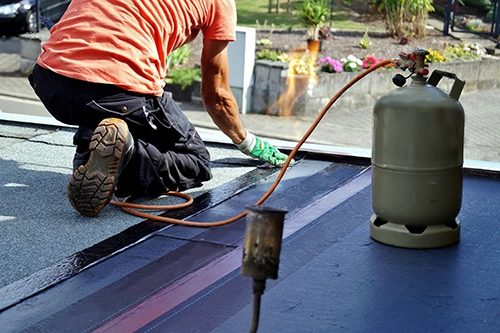- About Us
- Services
- Blog
- Contact
Need a quote?
Flat roof repair is a necessity when a leak occurs. Any issues with the roof could have serious consequences for the property and it’s not ideal, to say the least. Unfortunately, several things can easily go wrong, with one broken tile causing thousands of pounds worth of damage. Fixing the problem quickly can make a huge difference and may prevent mould and dampness from forming. So, what reasons could there be for a flat roof to leak?




You might not know it, but every building contracts and expands because of temperature changes. Architects consider this while designing a building. Unfortunately, membrane systems (that are used on roofs), weren’t designed for extensive movements. Flat roofs can have a lot of trouble because of these movements, and it means flat roof repair is needed more often.
One major cause of leaking is poor workmanship. This means the installation hasn’t been done properly and mistakes were made. The contractor could have cut corners or installed the tiles incorrectly. Flat roof repair would be necessary for those circumstances.
While all sorts can cause a leak to form, it is typically down to the age of the roof. Most roofing materials have a short lifespan, especially those made in the 60s and 70s, and it means flat roof repair is needed more frequently. The good news is that modern materials are created with longevity in mind which means they last longer. If age is a factor in leaks, it’s because it has reached the end of its life and must be repaired.
Blisters appearing on a roof is a sign water has become trapped within the structure. When blisters begin to form on the roof, it means flat roof repair is necessary. It could be down to the fact that the roof was soaked during installation and wasn’t dried properly. Moisture could remain trapped in the roof and cause blisters to form.
Another major reason for a leak to occur is down to poor design. This could be down to several things, including a shallow pitch, decks that have been spaced too far apart, and more. Flat roof repair would be a necessity and a complete overhaul might be needed to prevent the issue from reoccurring.
A leaking roof can create a mountain of problems, not to mention a (potentially) hefty repairs bill. The trouble is that the roof is your home’s security from the elements. It’ll prevent water from seeping in and keep your items safe. Flat roof repair is crucial and can be far easier than you think – when you have a skilled roofer working on the problem.
It depends on the construction, but the minimum weight a flat roof must be capable of bearing is 300lbs. This refers to a concentrated weight where a load is positioned on just one area of the roof. So, for example, a commercial flat roof can approximately support a 300lb HVAC unit in a 2.5×2.5ft single space.
If you opt for a flat roof anywhere on your property, remember that it comes with a need for proper maintenance. Low-slope roofing London-wide should be checked every six months or so, or after spells of bad weather, to spot any signs of damage. No matter how small, these should be addressed before they escalate. Remove any debris (leaves, twigs and so on) regularly to avoid these blocking the gutters and allowing water to pool and stand on the roof.
If there are trees in the close vicinity, keep them cut back to reduce the amount of foliage that falls on your flat roof. And check internally for signs of moisture, dampness or water damage on a regular basis. Spotting problems early means resolving them will be cheaper in the long run.

Building a flat roof can be done in three ways. The simplest and most cost-effective choice for levelled roofing London-wide is to construct a warm roof where a roofing membrane is placed over the insulation that keeps the timber structure warm. Another option is to create a cold roof where insulation is positioned between the rafters under the ply roof covering. This is commonly applied to flat-roofed extensions.
The third method is the hybrid roof that contains diverse elements. Their designs require a gap of ventilation above a warm roof to prevent excess moisture within the roof structure.
If you’re looking for flat roofing local contractors, don’t just select the first firm you come across. Find a roofing company that’s been in business for a while and can demonstrate a good track record in installing, repairing, and replacing flat roofs specifically. Ask for recommendations from your own network or from a local trade association. If you need refurbishment work done to 50% or more of your roof, you’ll need a roofing contractor who can self-certify their work under the Competent Person Scheme. Otherwise, the Building Control department at your local authority will need to approve the job before it begins.
Ask whether they are covered by liability insurance and how long they’ll guarantee the work they will carry out. And never just opt for the cheapest quote unless you’re quite sure they’re the best company for the job. You can’t afford to compromise on your roof as the structural integrity of your property depends on it.
Ensuring your flat roof will comply with building regulations before installation can save property owners time, money and stress. First, the roof must have a slope of around 1:80, with water draining away to one or two roof edges. Waterproofing must be extended up to the adjacent walls with at least 150 mm from the surface of the roof.
Contractors must install ventilation in cold roofs. For warm roofs, the deck must be bonded with a VCL. The roof should have the capacity to withstand strong winds and be sturdy enough to take an individual’s weight. Finally, check whether planning permission is needed. Typically, this is only required if you live in a conservation area or a listed building, or are making significant changes to an existing roof.
If you’re looking for top roofing solutions at competitive rates, check out our range of roofing services at Environ Roofing Company London. To get started, call one of our representatives today!

